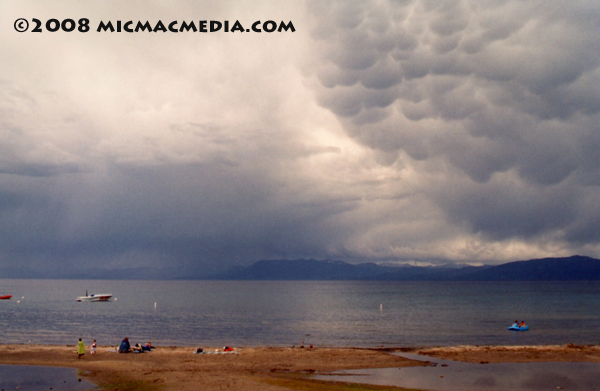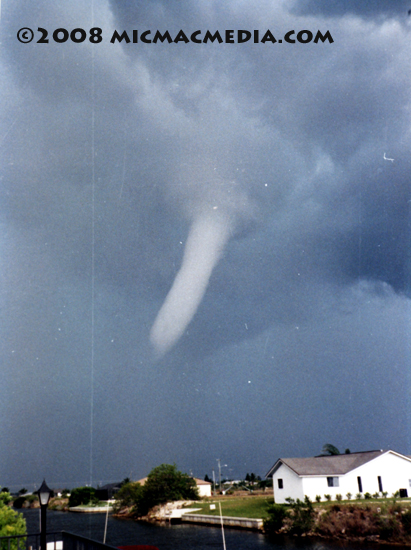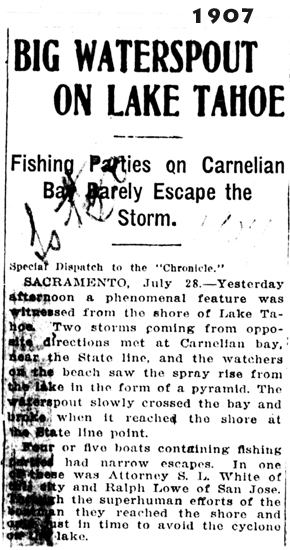 |
|
|
Follow Mark on Facebook for more stories |
||
 |
|||||
|
Tahoe Nugget #142 Sierra Twisters 2008 Summer is here and the living is easy. July boasts the warmest weather of the year in Nevada and the Sierra. It's a great time to enjoy all the natural beauty throughout this magnificent region, but mountain weather is capricious in any season, and it's always smart to keep an eye on the sky. This is the season when violent afternoon thunderstorms sometimes chase boats off lakes and force hikers to find shelter. Recently, on the afternoon of July 21, 2008, three supercell thunderstorms pounded western Nevada with torrential rain, quarter-size hail, and wind gusts near 70 mph. In their Public Information Statement released the next day, the National Weather Service office in Reno could not confirm any tornado touchdowns, but a trained weather spotter observed a funnel cloud near Fallon. Fortunately, there was little damage due to the lack of infrastructure and population in the affected region. The last time a twister touched down in western Nevada was 2004 when one hit the Reno area. Thunderstorms can generate deadly tornadoes and dangerous waterspouts. A waterspout is an intense column-shaped vortex of water spray that forms over a body of fresh or salt water. The "world's capital" for waterspouts is the Florida Keys, where peak velocities in the spray vortex exceed 100 m.p.h. Fortunately, on Lake Tahoe these aquatic whirlwinds usually don't last long or move onshore. Waterspout outbreaks over mountain lakes like Tahoe are extremely rare (primarily due to the cold water which does not provide an underlying heat source for cloud development), but a "family" of spectacular waterspouts, including one of the largest ever documented, was sighted on Lake Tahoe in September 1998. (See www.tahoetwisters.com for photos.) Funnel spouts occur when warm, moist air over the lake mixes with cool, dry air at a higher elevation. The United States claims 75 percent of the world's tornadoes, about 800 each year, but many Westerners have the erroneous notion that tornadoes are uncommon in California and Nevada. In fact, portions of the southern Los Angeles Basin and areas in California's Central Valley (including "tornado alley" in the corridor between Chico and Oroville) have tornado frequencies that rival those in the Great Plains. Tornadoes occur much less frequently in Nevada and the eastern Sierra; the Silver State ranks 44th out of all 50 states with one touchdown incident recorded in an average year. According to the National Weather Service, Nevada has had only 34 tornadoes since 1990. (Texas ranks first with an average of 123 confirmed tornadoes every year.) The tornado season here in the West corresponds with the United States as a whole. Tornado frequency increases during the thunderstorm season from April to October, but they are most numerous in May, June and July. Tornadoes in Nevada are rather weak compared to those that annually ravage the Great Plains, but as with other weather phenomenon in our region, they sometimes invade with surprising strength. The weather in July 1931 was sizzling hot. The West was caught in the grip of a severe drought and it seemed that the scorching sun was trying to finish off the ranchers and farmers. The average temperature that month was nearly 80 degrees, six degrees above normal and the warmest in Nevada's recorded history. Day after day Reno baked as high temperatures exceeded 100 degrees. During the last week of the month, thunderstorms began popping up throughout the region. In some areas, the volatile atmosphere brewed up more than nourishing rain showers. On July 24th, a potent thunderstorm near Las Vegas spawned what witnesses described as a tornado. At 5 p.m. that afternoon, motorists watched in horror as a spinning black cloud bounced and zigzagged its way toward the little community of Midway City. Earnest Bell, his wife and 3-year-old son were visiting the Leavy family. Few had the money to stay at a hotel during the Great Depression so the Bell's pitched their tent right next to the Leavy's small wooden cabin. Initially they had no concern about severe weather, but as the ominous storm cloud bore down on them, the tent began to shake violently and the Bell family prudently fled to the relative safety of the Leavy's cabin. Seconds later the tornado scored a direct hit on the cabin. The violent wind ripped the cabin from its foundation and sent the whole house tumbling, along with its helpless occupants. Mrs. Leavy was sitting on the bed when the twister struck. The tornado's vacuum pulled her and the mattress right out the window and flung them both high into the air. Miraculously, Mrs. Leavy rode the mattress like a "flying carpet," sailing over one house and landing in a heap in the desert, stunned but unhurt. The capricious twister had sucked her diamond wedding ring and wristwatch off her hand, but fortunately spared her life. Meanwhile the Bell family was being tossed from wall to wall as the cabin rolled across the desert sage. Finally the cabin, still intact, came to a stop. Badly shaken, Mrs. Bell and her son started to get up when Mr. Bell shouted, "Lay back down there!" At that very instant a powerful wind gust tore apart the whole house except for the wall they were crouched against. All three were slightly injured, but the Bell family had survived a close encounter with a Nevada twister. In all, nearly a dozen homes were destroyed and seven people hospitalized. Amazingly, no one was killed. After the wind abated, Ernest Bell limped back to see if he could salvage any of their possessions amidst all the wreckage. His eyes opened wide when he reached the spot. Their flimsy canvas tent was still standing there, completely intact and untouched by the raging tornado! Photo #1: Rare mammatus clouds over Tahoe indicate a very moist and unstable atmosphere. Mammatus cloud formations often precede tornado activity.
|
|||||
|




